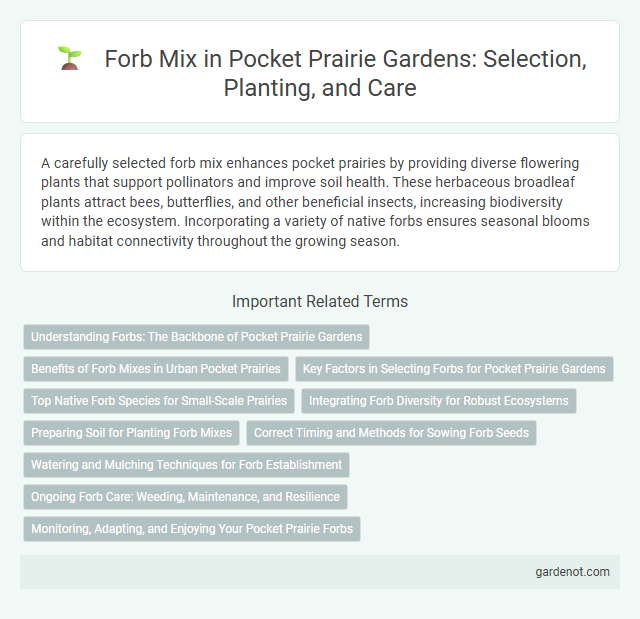A carefully selected forb mix enhances pocket prairies by providing diverse flowering plants that support pollinators and improve soil health. These herbaceous broadleaf plants attract bees, butterflies, and other beneficial insects, increasing biodiversity within the ecosystem. Incorporating a variety of native forbs ensures seasonal blooms and habitat connectivity throughout the growing season.
Understanding Forbs: The Backbone of Pocket Prairie Gardens
Forbs constitute the essential herbaceous flowering plants that form the backbone of pocket prairie gardens, providing diverse structure and vibrant color. These broad-leaved plants support pollinators and enhance soil health by fostering microbial activity and preventing erosion. Selecting a well-balanced forb mix tailored to local ecosystems ensures resilience, biodiversity, and long-term sustainability within pocket prairie landscapes.
Benefits of Forb Mixes in Urban Pocket Prairies
Forb mixes in urban pocket prairies enhance biodiversity by attracting a wide range of pollinators such as bees, butterflies, and other beneficial insects, promoting ecosystem health. These diverse flowering plants improve soil structure and nutrient cycling, contributing to urban green space resilience. Furthermore, forb mixes provide aesthetic value and seasonal interest, making pocket prairies valuable community assets and supporting urban wildlife habitats.
Key Factors in Selecting Forbs for Pocket Prairie Gardens
Selecting forbs for pocket prairie gardens requires prioritizing native species adapted to local soil and climate conditions to ensure resilience and ecological compatibility. Key factors include bloom periods to maximize pollinator support throughout the growing season and plant height diversity for structural complexity and habitat variety. Consideration of drought tolerance and low maintenance needs enhances sustainability and reduces resource inputs in pocket prairie restoration projects.
Top Native Forb Species for Small-Scale Prairies
Top native forb species for small-scale pocket prairies include Echinacea purpurea (purple coneflower), Asclepias tuberosa (butterfly weed), and Rudbeckia hirta (black-eyed Susan), known for their adaptability and vibrant blooms. These species support pollinators such as bees and butterflies while enhancing soil health with deep root systems. Incorporating a diverse forb mix promotes ecological balance, fosters wildlife habitat, and ensures seasonal visual interest throughout the growing season.
Integrating Forb Diversity for Robust Ecosystems
Incorporating a diverse forb mix in pocket prairie planting enhances habitat complexity and supports pollinator populations, crucial for ecosystem robustness. Native forb species such as coneflowers, black-eyed Susans, and milkweed provide essential nectar sources and improve soil health through nitrogen fixation. This diversity promotes resilience against pests and environmental stressors, ensuring sustainable ecosystem functions.
Preparing Soil for Planting Forb Mixes
Preparing soil for planting forb mixes involves loosening compacted soil to enhance root penetration and water infiltration, which promotes vigorous growth of wildflowers and native forbs. Incorporating organic matter, such as compost or aged manure, enriches soil fertility and supports microbial activity critical for healthy plant development. Proper soil pH, ideally between 6.0 and 7.0, ensures nutrient availability tailored to the needs of diverse forb species within the pocket prairie.
Correct Timing and Methods for Sowing Forb Seeds
Sowing forb seeds in a pocket prairie requires precise timing, ideally targeting late fall or early spring to align with natural germination cycles and moisture availability. Employing methods such as shallow broadcasting followed by light raking ensures optimal seed-to-soil contact without burial, promoting higher germination rates. Using a diversity of forb species tailored to local soil and climate conditions enhances establishment success and supports pollinator populations.
Watering and Mulching Techniques for Forb Establishment
Effective watering and mulching techniques are crucial for successful forb mix establishment in pocket prairies. Maintaining consistent soil moisture through deep, infrequent watering encourages deep root growth, enhancing drought resilience. Applying organic mulch like shredded leaves or straw helps retain soil moisture, regulate temperature, and suppress weed competition, promoting optimal forb development.
Ongoing Forb Care: Weeding, Maintenance, and Resilience
Regular weeding is essential for ongoing forb care in pocket prairies, preventing invasive species from outcompeting native forb mixes. Consistent maintenance, including selective thinning and monitoring soil health, supports robust forb growth and biodiversity. Building resilience through adaptive management helps pocket prairies withstand environmental stressors such as drought and pests.
Monitoring, Adapting, and Enjoying Your Pocket Prairie Forbs
Monitoring your pocket prairie forb mix involves regular observation to assess plant health, growth patterns, and biodiversity, which ensures optimal ecosystem function. Adapting management practices based on seasonal changes and environmental feedback helps sustain forb diversity and resilience against invasive species. Enjoying your pocket prairie forbs includes appreciating their ecological benefits, such as pollinator support and soil improvement, while fostering a thriving natural habitat in a compact space.
Forb mix Infographic

 gardenot.com
gardenot.com